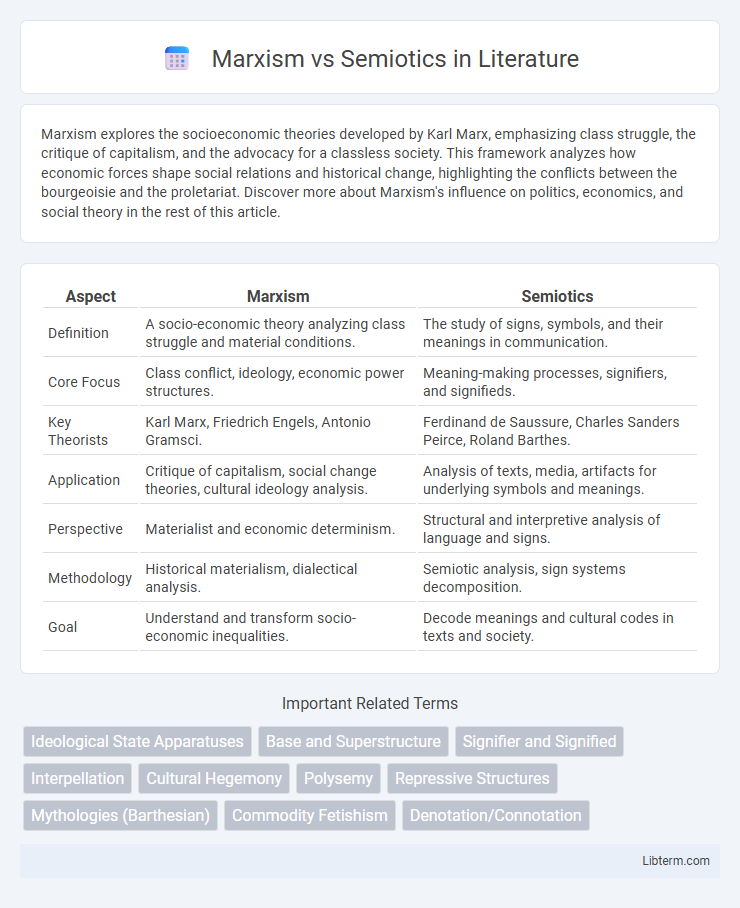Marxism explores the socioeconomic theories developed by Karl Marx, emphasizing class struggle, the critique of capitalism, and the advocacy for a classless society. This framework analyzes how economic forces shape social relations and historical change, highlighting the conflicts between the bourgeoisie and the proletariat. Discover more about Marxism's influence on politics, economics, and social theory in the rest of this article.
Table of Comparison
| Aspect | Marxism | Semiotics |
|---|---|---|
| Definition | A socio-economic theory analyzing class struggle and material conditions. | The study of signs, symbols, and their meanings in communication. |
| Core Focus | Class conflict, ideology, economic power structures. | Meaning-making processes, signifiers, and signifieds. |
| Key Theorists | Karl Marx, Friedrich Engels, Antonio Gramsci. | Ferdinand de Saussure, Charles Sanders Peirce, Roland Barthes. |
| Application | Critique of capitalism, social change theories, cultural ideology analysis. | Analysis of texts, media, artifacts for underlying symbols and meanings. |
| Perspective | Materialist and economic determinism. | Structural and interpretive analysis of language and signs. |
| Methodology | Historical materialism, dialectical analysis. | Semiotic analysis, sign systems decomposition. |
| Goal | Understand and transform socio-economic inequalities. | Decode meanings and cultural codes in texts and society. |
Introduction to Marxism and Semiotics
Marxism explores socio-economic structures through the lens of class struggle, emphasizing material conditions and historical change as drivers of societal dynamics. Semiotics studies the use of signs and symbols as a means of communication and understanding meaning within cultural contexts. Both frameworks analyze systems of meaning, with Marxism focusing on ideology and power relations, and Semiotics on signification and interpretation processes.
Historical Contexts of Marxism and Semiotics
Marxism emerged in the 19th century amid the Industrial Revolution, addressing class struggles and economic inequalities through a materialist lens. Semiotics, formalized in the early 20th century by theorists like Ferdinand de Saussure and Charles Sanders Peirce, developed as the study of signs and symbols within cultural and communicative contexts. While Marxism examines socio-economic power dynamics and historical materialism, Semiotics focuses on meaning-making processes shaped by cultural and linguistic structures.
Core Principles of Marxist Theory
Marxist theory centers on class struggle, historical materialism, and the critique of capitalist modes of production, emphasizing how economic base shapes social structures and consciousness. In contrast, semiotics analyzes the system of signs and symbols that construct meaning within cultural contexts, focusing on language, communication, and representation. While Marxism critiques societal power dynamics rooted in material conditions, semiotics investigates the abstract processes through which ideology and meaning are encoded and decoded.
Fundamental Concepts in Semiotics
Semiotics centers on the study of signs and symbols as fundamental units of meaning, emphasizing concepts like signifier, signified, and the interpretant to decode communication processes. Marxism interprets social phenomena through the lens of class struggle and material conditions, often critiquing ideological constructs as reflections of economic base structures. While Marxism prioritizes socio-economic realities, semiotics provides tools to analyze how meaning is constructed and disseminated across cultural texts and practices.
Differences in Analyzing Culture and Society
Marxism analyzes culture and society primarily through the lens of economic class struggle, focusing on material conditions and modes of production as the foundation of social relations. Semiotics studies culture by examining signs, symbols, and language, interpreting how meaning is constructed and communicated within social contexts. While Marxism emphasizes power dynamics rooted in economic structures, semiotics prioritizes the role of representation and discourse in shaping cultural understanding.
Approaches to Ideology: Marxism vs. Semiotics
Marxism approaches ideology as a system of dominant ideas imposed by the ruling class to maintain material power and economic relations. Semiotics analyzes ideology through signs and symbols embedded in language and culture, revealing how meaning is constructed and naturalized within social contexts. Together, these frameworks uncover both the economic foundations and communicative processes that perpetuate ideological control.
The Role of Language and Power
Marxism analyzes language as a tool shaped by and reinforcing class struggle, where power manifests through ideology and material conditions, emphasizing language's role in maintaining capitalist dominance. Semiotics studies language as a system of signs and symbols, revealing how meaning is constructed and how power operates through cultural codes and discourse. Both frameworks highlight language as a medium of power, with Marxism focusing on economic relations and Semiotics on ideological structures within communication.
Case Studies: Literature and Media Analysis
Marxism analyzes literature and media through class struggle, ideology, and economic power dynamics, revealing how cultural texts reflect and reinforce capitalist structures. Semiotics deconstructs signs, symbols, and codes within these texts, uncovering multiple layers of meaning and viewer interpretation beyond economic context. Case studies in media such as films, advertisements, and novels demonstrate how Marxist critique exposes societal inequalities while semiotic analysis deciphers embedded cultural myths and ideological messages.
Critiques and Limitations of Each Framework
Marxism faces critiques for its economic determinism, often overlooking cultural and ideological complexities beyond class struggle. Semiotics is criticized for its abstract focus on signs and meanings, sometimes neglecting material conditions and power relations emphasized in Marxist theory. Both frameworks struggle with limitations in addressing the full spectrum of social phenomena independently, highlighting the need for integrated approaches.
Conclusion: Synergies and Divergences
Marxism and Semiotics intersect in their analysis of social structures and ideology, with Marxism emphasizing class struggle and material conditions, while Semiotics focuses on signs and meaning-making processes. Both frameworks uncover power dynamics, but Marxism critiques economic exploitation whereas Semiotics decodes cultural symbols and discourses. Their synergy lies in a combined approach to social critique, yet divergence persists due to Marxism's economic foundation contrasting with Semiotics' linguistic and interpretive emphasis.
Marxism Infographic

 libterm.com
libterm.com